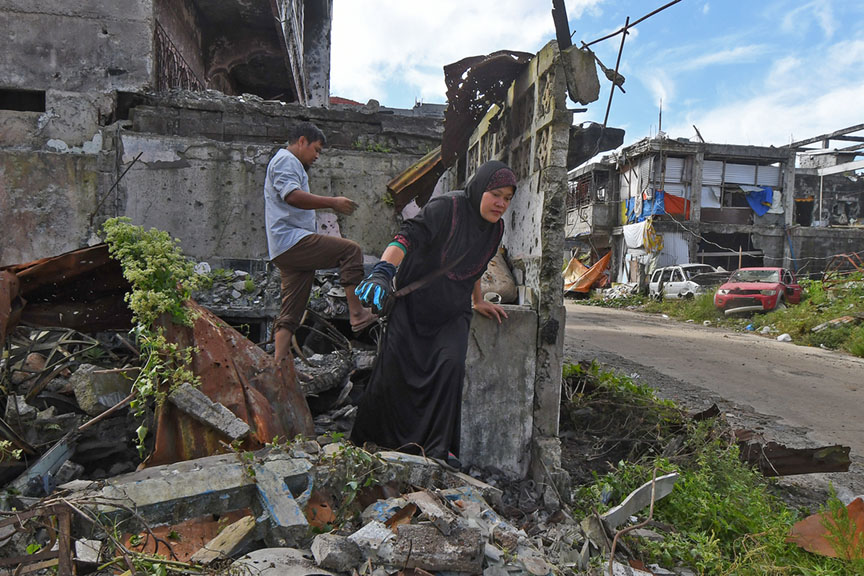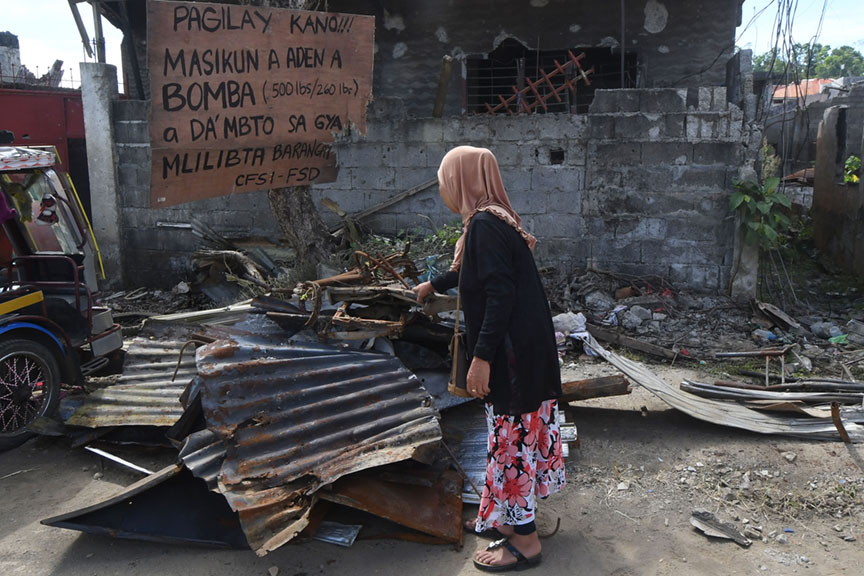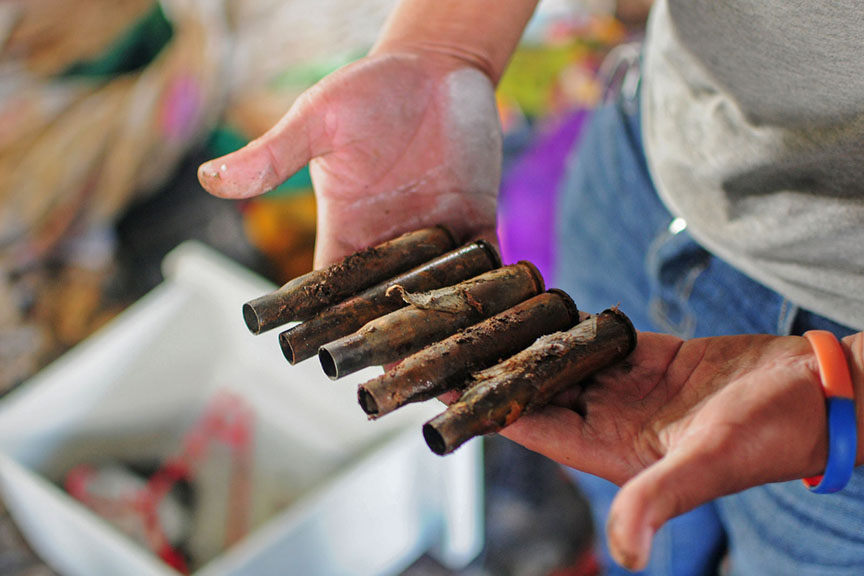MARAWI CITY (MindaNews / 06 April) – It was not easy to hear that your house did not survive the war but when 62-year-old Rasamala Magondaraya and her children entered the ruins of what used to be their four-story building, she was appalled.
 Residents search for what remains in their former house. MindaNews photo by FROILAN GALLARDO
Residents search for what remains in their former house. MindaNews photo by FROILAN GALLARDO
There were holes in the wall and a huge pit dug on what used to be the living room where she and her children gathered in happier times.
Entire sections of the building had collapsed under heavy bombardment and “ISIS” graffiti were spray-painted on what remained of the walls.
“This is what I found,” Magondaraya said holding up an identification card as watcher in the 2013 mid-term elections.
“At least I still have some identity left,” she said.
Her children fared no better, rummaging only a few clothes that they were able to salvage from the rubble.
Two blocks away, Samia Macondara, 35, held back her tears when she saw that what remained of her bakery and grocery store was a pile of concrete and twisted steel.
 Samia Macondara and brother Abdul walk through what used to be her small bakery and grocery store. MindaNews photo by FROILAN GALLARDO
Samia Macondara and brother Abdul walk through what used to be her small bakery and grocery store. MindaNews photo by FROILAN GALLARDO
Macondara said that when she left her store on May 24,2017 — a day after the start of the five-month siege — she had hidden P37,000 inside a small vault.
Last Thursday, Macondara and her brother, Abdul, looked everywhere but the vault is gone, and with it, her dreams of getting back quickly on her feet.
Since they fled Marawi, Macondara lived as a refugee and depended on food aid given by government agencies and NGOs.
She has since left the evacuation camp in neighboring Balo-i, Lanao del Norte, and transferred to a farm of a relative in a nearby village.
“We have been subsisting on root crops since then. At least we have that but I want to have is my business back again,” Macondara, a mother of two, said.
 A sign posted on a tree in Marawi City warns of unexploded ordnance, including 500-pound aerial bombs. MindaNews photo by FROILAN GALLARDO
A sign posted on a tree in Marawi City warns of unexploded ordnance, including 500-pound aerial bombs. MindaNews photo by FROILAN GALLARDO
Kambisita
Nearly 11 months after they fled their villages, residents of Ground Zero, the former Main Battle Area between government forces and the Maute Group and its allies (now referred to a MAA or Most Affected Area), have been allowed to “visit their homes and retrieve their personal belongings” through Kambisita sa MAA (Visit the MAA), a project of the City Government of Marawi and Task Force Bagong Marawi (TFBM).
Home to 24 barangays, the MAA has been divided into nine sectors and residents are allowed to visit only for three days per sector, from 6 a.m. to 3 p.m. on April 1 to May 10.
Magondaraya and Macondara are part of the second batch (April 5 to 7).
The visits are fraught with danger.
Down the road, a sign hangs on a tree warning residents to be careful of unexploded bombs.
Col. Romeo Brawner Jr., deputy commander of the Joint Task Force Ranao said a still undetermined number of unexploded ordnance and improvised explosive device remain unaccounted.
The deadliest are the 500-pound General Purpose bombs dropped by the Philippine Air Force (PAF) FA50 jet planes.
Brawner said according to the PAF, 17 of these bombs did not explode during the bombardment of Marawi last year.
 Empty 50-caliber shell casings are found by a resident when he visited his house in Marawi City. MindaNews photo by FROILAN GALLARDO
Empty 50-caliber shell casings are found by a resident when he visited his house in Marawi City. MindaNews photo by FROILAN GALLARDO
“Army ordnance disposal teams found only nine of the bombs. There are still eight bombs out there,” Brawner said.
He said that during the Sector 1 visit on April 1 to 3, the teams were able to recover an unexploded 60mm mortar round and two 40mm grenades in the ruins of the buildings.
The military is asking residents to report any suspicious objects or unexploded ordnance they find.
Brawner said the military so far recovered 1,178 unexploded bombs and 323 improvised explosive devices since the fighting ended last October.
He said the bomb disposal teams are using K9 dogs and manually defusing the bombs instead of cutting edge technology, which the Army does not have.
“Ordnance clearing teams are slowly combing the rubble and hope to finish it by the end of June. Although it does not mean 100-percent clear,” Major General Roseller Murillo, chief of the Army 1stDivision said.
Military reservation issue
The visits of residents are closely monitored by the military. The families are instructed to stay inside their barangays or sectors.
The families are packed in private vehicles that snake through two checkpoints within the “most affected area.”
No one is allowed to stray. Food and water bottles are provided to the families.
Assistant Secretary Felix Castro, field office manager of TFBM, said residents would not be allowed to rebuild their houses until the area is cleared of debris and ruined buildings.
He said a business consortium of Chinese and Filipino firms led by China State Construction Engineering Corp. Ltd. will lead in the development of the “new Marawi.”
A technical team is currently evaluating the project proposal, costs and other details of the consortium led by the China State Construction Engineering Corp. Ltd.
Castro said a major issue to be resolved is the “colonial settlement” title of military reservation of Marawi City.
The late President Elpidio Quirino signed Presidential Proclamation 453 on Dec. 23, 1953 classifying 6,667 hectares in much of the present Marawi City as a military reservation.
Quirino based the proclamation on an earlier proclamation by US President William McKinley in 1902.
Past Philippine presidents had partitioned some 8,644 hectares for different purposes but according to Land Management Bureau, Marawi has only 8,396 hectares.
“This issue has to be resolved before the consortium can start the reconstruction of Marawi,” Castro said.
He said residents with land titles can rebuild their houses once the debris and ruined buildings are cleared. (Froilan Gallardo / MindaNews)
